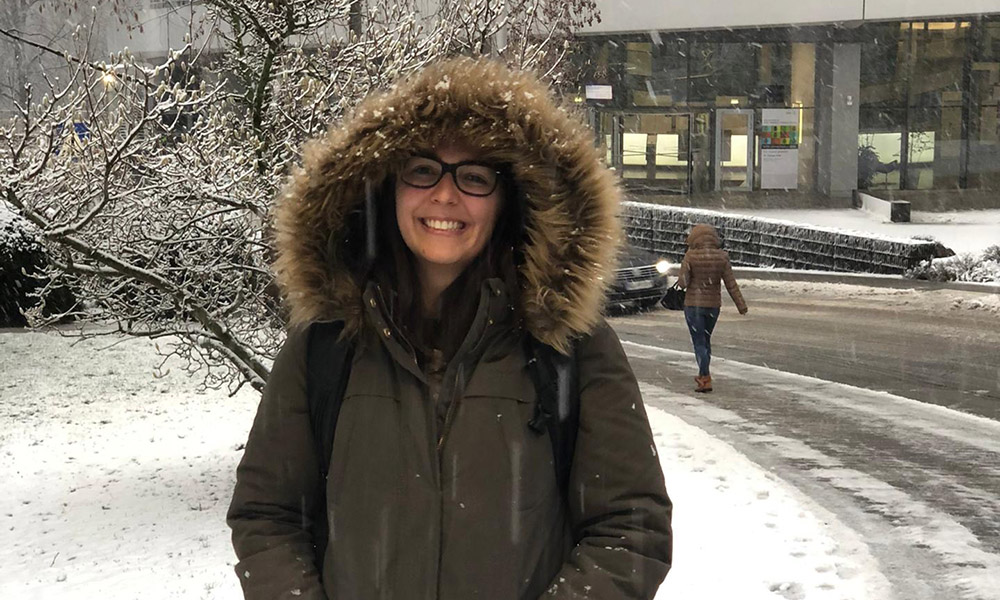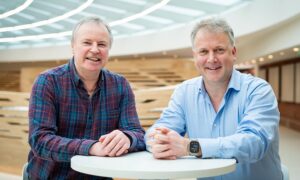
EMBL Scientific Visitor Programme opens eyes and doors
Participant from Portugal defines career path and pursues a PhD in medical imaging

As a young girl, Silvia Dias Almeida learned resolve from a mother who studied for her own university degree each night after the dinner table was cleared, and then again after she put a young Silvia to bed. Silvia’s mother soon became an agronomic engineer, exemplifying the drive to succeed in science.
Maths and physics came easily to Silvia and seemed to lead her from one academic step to the next – a path that she thought would not go outside her Lisbon-area hometown in Portugal. It turned out that EMBL would help define the path ahead.
Facilitated by EMBL’s Scientific Visitor Programme in 2019, Silvia spent a year in the Diz-Muñoz group. It helped her decide that a PhD was the right next step, and made her a unique candidate for her first-choice programme: the highly competitive biomedical imaging track at the DKFZ International PhD Programme in Heidelberg, as part of the International Graduate School for Cancer Research.
“Scientists and students from around the world come to EMBL to take advantage of state-of-the-art equipment and world-renowned scientific leadership,” says Claudia Martin, who oversees the programme as an Administrator in EMBL’s International Centre for Advanced Training. “I think this programme reflects the EMBL principle very well: a member state sends their young scientists to EMBL, where they learn a lot and kick-start their scientific career, participate in collaborations, and ultimately bring knowledge and experience back to their home country.”
Silvia had completed bachelor’s and master’s degrees in biomedical engineering and medical image analysis, which would have enabled her to obtain an immediate position in industry. In fact, she analysed cancer medical images, even spending a year developing an algorithm to evaluate tumours using MRI images at Champalimaud Centre for the Unknown in Lisbon. But she wondered what other options were out there.
She heard about a programme run by Fundação para a Ciência e Tecnologia (FCT), a Portuguese public agency, based in Lisbon, that supports science, technology, and innovation. “They were financing people to go to big international organisations in Europe, including EMBL,” says Silvia. “I went from not knowing about EMBL to realising that this is a big institute with several sites doing incredible research.”
EMBL has had an agreement with FCT since 2017, whereby FCT provides funding for up to two graduates to spend a year at EMBL. Silvia was the first to participate in the scheme. She believed that EMBL would help her experience life in an international research organisation for enough time that she could substantively contribute to research and gain exposure to other biological imaging and career development opportunities in the process. Six months after she applied to spend a year at EMBL, she was talking to EMBL group leader Alba Diz-Muñoz about the role she might play in a lab that explores how physical forces and material properties regulate biological processes.
“I was nervous because Alba was doing research in a topic I wasn’t familiar with,” Silvia says. “I worked with a PhD student, Ewa Sitarska. We’d analyse movies of cells to see how they moved and behaved with other cells, then describe it computationally.” The relationship between Silvia and Ewa proved so fruitful that they continue to collaborate even though Silvia is no longer at EMBL.
At EMBL, Silvia also discovered numerous scientific lectures, career development talks, and professional conferences. “I wasn’t used to the variety of research topics, and they were presented by scientists from all over the world,” she recalls. “The networking opportunities were impressive.”
A key moment came at an EMBL conference on image analysis, when Mónica Bettencourt-Dias, director of the Instituto Gulbenkian de Ciência and an EMBO member, gave a talk. “To see a woman from Portugal speak at this international conference in Germany was honestly an inspiration,” Silvia says. “There aren’t as many opportunities in smaller countries because there’s simply less funding. Yet her work was valued as a part of this overall conference – as part of the global conversation.”
Silvia likes to describe her experience at EMBL as having refined her scientific thinking and coding skills. It’s also where she reconfirmed her interest in pursuing biomedical imaging, making her realise that she now needed a PhD. She knew where she wanted to do that, too.
Today, Silvia remains in Heidelberg for doctoral work at the German Cancer Research Center (DKFZ), using computer tomography to better understand how primary diseases can give rise to secondary diseases that are even more deadly (for example, some types of cancer can give rise to coronary artery disease or diabetes). “It’s easy to get lost doing a PhD, if you don’t have clear motivation,” Silvia says. “I found a great programme at EMBL, and it gave me the skills I needed. That was important. There are so many voices in your head that will say you’re not good enough. But EMBL gave me the background and the confidence to look at myself as someone who can do this.”


